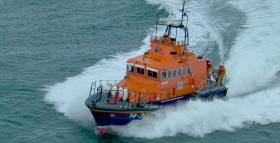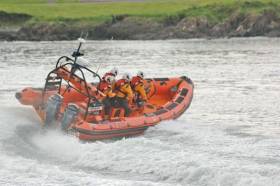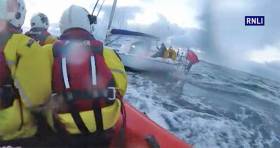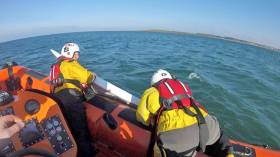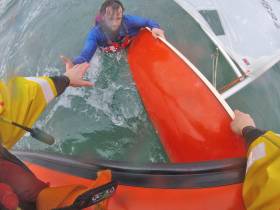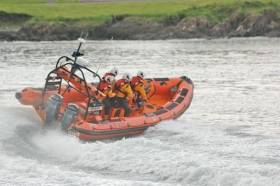Displaying items by tag: Bangor
#RNLI - Lifeboat crews from Ireland will feature in a new 12-part Last year alone, RNLI lifeboats in Ireland documentary for the BBC.
Saving Lives at Sea, showcasing the lifesaving work of the RNLI, starts next Wednesday 16 August at 8pm on BBC Two.
And the first episode will include the dramatic rescue of three fishermen from a sinking trawler and the rescue of 30 people from the Astrid tall ship in Kinsale.
The 12-part series features real rescues carried out by the charity’s lifeboat crews around Ireland and the UK, and gives a unique insight into the lives of the charity’s volunteer lifeboat crew members, who rescue thousands of people and save hundreds of lives around our coastline every year.
From Ireland, the series will feature lifeboat crews from Castletownbere and Kinsale in Cork, Skerries in Dublin and Bangor on Belfast Lough.
Castletownbere will be in episode three, as the crew rescue a lone sailor in storm conditions and rescue two fishermen from a boat that sinks.
Saving Lives at Sea features real-life rescue footage accompanied by heart-warming and emotive testimonials from the crew and the people they rescue.
The series has been filmed over the past year, with lifeboat crews using RNLI and special cameras and welcoming filmmakers into their day-to-day life. Rescues from the RNLI’s archives are also revisited.
Last year alone, RNLI lifeboats in Ireland launched 1,136 times rescuing 1,649 people.
Saving Lives at Sea will be broadcast weekly from Wednesday 16 August to Wednesday 1 November on BBC Two at 8pm. The series is made for the BBC by Blast! Films.
Volunteers from Donaghadee and Bangor RNLI were requested to launch their lifeboats this evening (Thursday 3 August) after a group of dinghy sailors got into difficulty off the County Down coast.
The inshore lifeboat from Bangor and the all-weather lifeboat from Donaghadee launched shortly after 5pm following a report from Belfast Coastguard that two dinghies with 10 people onboard were in difficulty in an area off South Briggs.
Weather conditions at the time were dry and sunny with a north west Force 4 wind blowing.
The sailors had got caught out by an offshore wind which made it difficult for them to make any headway back to land.
Once on scene, the lifeboat crews observed that the five people onboard each dinghy had managed to regain control.
Both lifeboats then escorted the sailors safely back to Ballyholme.
Speaking following the call out, Peter Irwin, Donaghadee RNLI Lifeboat Operations Manager said: ‘Sailing is a popular activity on the County Down coastline especially at this time of year. Weather can change no matter how well you prepare for your trip and it was an offshore wind that caused problems this evening but thankfully all are safe and well. We would remind anyone going to sea this summer to respect the water. Always wear a lifejacket and always carry a means of calling or signalling for help. Should you get into difficulty dial 999 or 112 and ask for the Coastguard.’
#RNLI - During the Sea Bangor Festival over the weekend, Bangor RNLI was delighted to welcome Jackie Patton of Ballyholme Yacht Club and Robert Montgomery from the Belfast Kayak Club to receive a cheque for £1,700 raised for the lifeboat station in the fifth annual Bangor Bay Sea Kayak Race last month.
Receiving the cheque was deputy launching authority Bryan Lawther, watched by crew members Kyle Marshall, Kat Lindsay, Joanne Heasley and Richard McClinton - and not forgetting Stormy Sam.
Thanking Patton and Montgomery, Lawther said: “As a charity, It is events like yours that raise the money we need to protect the waters around our coast.
“And the event itself gave us the opportunity to discuss sea safety with all participants.”
Rain Stays Away For Bangor Bay Sea Kayak Race
#SeaKayaking - Belfast Lough escaped the rain as the fifth Bangor Bay Sea Kayak Race was held in great conditions yesterday afternoon (Saturday 27 May).
Organised by Jackie Patton of Ballyholme Yacht Club and members of Belfast Kayak Club, and with all proceeds going to the RNLI, more than 70 kayakers and paddle boarders took to the water in a wide variety of craft, and were seen on their way by a volunteer crew from Bangor RNLI.
Before taking to the water, each kayak was checked by organisers to make sure it met the required safety standard, and that every competitor was suitably attired.
Delighted by the turnout, Jackie Patton said afterwards: “This event gets better every year, with more boats taking part, and the pre-race checks give us a perfect opportunity to reinforce key safety messages with the kayakers.”
RNLI community safety officer Peter E Bullick was also on hand to offer safety advice to competitors.
Following the event, the prizegiving was held in Ballyholme Yacht Club, and Bangor RNLI lifeboat operations manager Kevin Byers thanked everyone for their generosity and said it was events like this that provided vital funds to the RNLI.
Unfortunately, the start of the race was delayed by an unrelated accident on one of the yacht club’s slipways, as safety boats were being launched.
The Bangor RNLI crew were among the first to attend, and were able to put their first aid training into practice by helping to lift the casualty into the ambulance.
Helmsman Gareth Whan said: “There are always danger points when launching boats, and this accident highlights the fact that accidents happen off the water as well as on.
“The crew and I were delighted to be able to offer some assistance to the casualty, and we wish him well for a full recovery.”
#Missing - RNLI lifeboats from Bangor and Donaghadee have joined the search for a speedboat with two men missing off the Scottish coast, as BBC News reports.
Coastguard volunteers from Bangor are also part of the emergency operation launched last night (Saturday 6 May) when the two men failed to return to Port Logan in Dumfries and Galloway.
Searches for the missing vessel, thought to be an 18ft black Fletcher speedboat, are concentrated off the Mull of Galloway for the time being.
BBC News has more on the story HERE.
Missing Toddler Report Prompts Bangor Lifeboat Launch
#RNLI - Bangor RNLI’s volunteers launched the inshore lifeboat Jessie Hillyard yesterday evening (Monday 24 April) to reports of a missing three-year-old in the vicinity of the Jamaica Inn.
Setting off in big breaking seas and a Force 8 gusting wind, helmsman Kyle Marshall and crew John Bell and Johnny Gedge made their way to Luke’s Point.
En route, the information was changed to a seven-year-old boy who had run off from his parents’ car.
With Donaghadee RNLI getting ready to launch, and the PSNI and HM Coastguard in attendance on land at Luke’s Point, Bangor RNLI were informed that the boy was found to have made his own way home and was safe.
Commenting on the callout, Marshall said: “The crew and I are delighted that this young lad has been found safe and is back with his family. Conditions were challenging this evening, but this is what we are trained to handle.
“There is no substitute for experience on a call like this, and keeping the crew safe is a top priority. In high seas and strong winds, ‘softly softly catchy monkey’ is the way to go.”
Bangor Lifeboat Helps Yacht With Three On Board To Safety
#RNLI - A volunteer crew from Bangor RNLI was tasked with helping a yacht with three people and a dog on passage from Girvan in Western Scotland to Bangor Marina yesterday (Monday 10 April).
The yacht had a fouled prop and was making slow headway into the wind. Without engine power, they were unable to make their way safely to the Belfast Lough marina.
The inshore lifeboat, led by helmsman Peter Semple, attended – and as they approached the yacht they were informed the fouled prop had freed itself.
The crew offered to escort the yacht to safety to avoid further risk, and this offer was gratefully received.
Once in the marina, the lifeboat ensured all was well and returned to station.
Semple said: "We are delighted to have helped this yacht into the safety of Bangor Marina. In the event, we were not needed to tow the vessel, but the crew were happy to see us.”
#RNLI - At the end of a busy week for Bangor RNLI, the Belfast Lough volunteer crew launched to the rescue of two young paddleboarders who had got into difficulty just outside Ballyholme Bay yesterday (Saturday 8 April).
Launching just after 5pm following a call from the public, the Bangor lifeboat Jessie Hillyard launched to aid two girls who had been caught out by an offshore wind that was causing them to drift further out to sea.
Although it was a beautiful afternoon weather-wise, the girls hadn’t factored in the offshore wind, and this led to them getting more tired as they tried to return to base at Ballyholme Yacht Club.
The Bangor lifeboat, helmed by Peter Semple, made light work of picking up the girls and their boards and returning them to the slipway at the yacht club, where they were passed into the care of HM Coastguard.
After the rescue, Semple said: “We are delighted to have been able to return the two girls to safety. On arrival at the scene we were pleased to see that they were both wearing wetsuits and buoyancy aids, and had just misjudged the offshore wind.”
Bangor Lifeboat Rescues Man From Capsized Dinghy
#RNLI - Following yesterday’s hoax calls, Bangor RNLI’s lifeboat volunteers rescued a man clinging to a capsized dinghy in Ballyholme Bay this afternoon (Monday 3 April).
The casualty, a 26-year old man, had quickly got into difficulty and capsized after launching from the Belfast Lough beach in a strong offshore wind gusting up to 30 knots.
This was seen by a member of the public who called 999, and CGOC Belfast Coastguard requested Bangor RNLI to respond.
Arriving on scene within minutes, the crew were delighted to see that the man had stayed with his boat and not tried to make it to shore. They were also happy to report that he was wearing appropriate safety gear: a wetsuit with a buoyancy aid.
After taking the casualty on board and assessing that he was uninjured, they returned him and his boat to the beach where the coastguard were waiting to assist.
Bangor lifeboat helm James Gillespie said: “This man clearly made the wrong decision to attempt to sail in a new boat in such conditions, but by wearing appropriate wet weather gear and staying with his boat he made our rescue much easier.
“The body tires quickly is cold water and he made the right decision to stay with his boat, knowing that his plight had been seen from the shore.”
Bangor RNLI’s deputy launching authority, Bryan Lawther added: “We are delighted to have been to help this man and bring him to safety. He has been advised to further his sailing knowledge with the assistance of a yacht club where rescue services are always on hand for learners.
“After yesterday’s hoax calls, this rescue highlights the importance of our service and our willingness to attend any genuine call.”
Bangor Lifeboat Saves Swimmer In Ballyholme Bay
#RNLI - At 8.10am this morning (Wednesday 28 December), Bangor RNLI’s volunteer crew responded to a request from HM Coastguard to rescue a young man reported to be in difficulty while swimming 200 metres off the shore in Ballyholme Bay.
The alarm was raised by Ards and North Down council employee Mark Pollock as he was working in Banks Car Park. Hearing faint shouts, he initially thought it was someone calling for their dog, but persevered looking in the sea until he became aware that there was someone in the water.
Bangor RNLI’s volunteer crew responded within minutes and made their way to Ballyholme Bay.
Helmsman James Gillespie said later: “On arrival, the early morning light made it difficult to see, but fortunately the water was flat calm, and on scanning the area I saw a slight movement as the casualty raised his hand.”
Heading quickly to the scene, crew member Johnny Gedge entered the water to support the casualty, who was only just conscious, until he could be lifted on board the lifeboat, where crew members Joanne Heasley and Jack Irwin put their casualty care training to good use.
Gillespie added: “Our extensive training in casualty care is invaluable at a time like this. Because of this, we know the importance of not trying to warm the patient too quickly as this can cause cardiac arrest.
“Instead, we made the patient safe, and prevented further cooling, and returned as quickly and safely as we could to the lifeboat station where an ambulance and paramedics were waiting to take over.”
The patient, who is thought to be in his late 20s, was wearing only tracksuit bottoms, a T-shirt and socks, and it is unknown why he was in the water.
A shocked Pollock said: “I am just delighted that I heard his calls, and hope he makes a full recovery.”
Speaking after the ambulance left to take the patient to hospital, Bangor’s lifeboat operations manager Kevin Byers said: “I understand from talking to medical personnel at the scene, that only five minutes more in the water would have been fatal, and that the crew took exactly the right actions to give this young man the best chance of a full recovery.
“I am always proud of my team, but their response this morning was magnificent. Not just the four crew members on the boat, but the many others who responded to their pagers and were prepared to do whatever they could to help.”






























